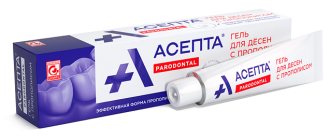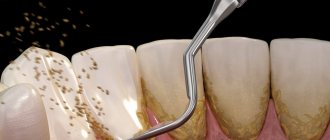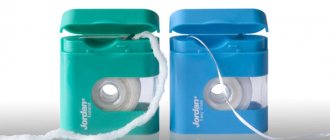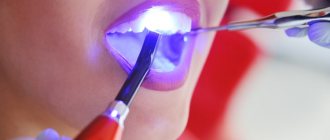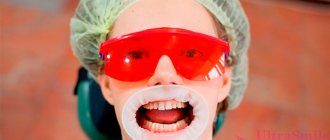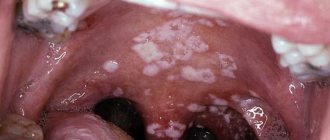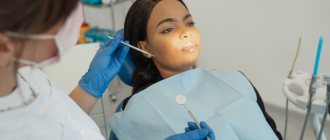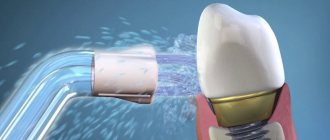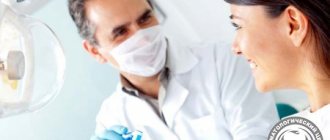Professional oral hygiene is comprehensive care aimed at preventing dental diseases. The technology allows you to get a “brilliant” result in one hour and achieve natural whiteness.
The procedure includes removing plaque using the Air Flow method and cleaning hard plaque with an ultrasonic scaler. At the final stage, fluoridation and remotherapy are performed to strengthen the enamel. In addition, the attending physician teaches the patient about home hygiene and selects care products. Professional care is highly effective, but maintaining the results is only possible if all the dentist’s instructions are followed.
What can you eat after cleansing?
After the procedure, dentists impose a number of restrictions on the patient’s eating behavior. In the first 2-3 days, foods that irritate tooth enamel are excluded from the diet: sour, hot, salty, sweet. The sensitivity of teeth after ultrasonic cleaning of stone is increased: bright tastes and temperature changes provoke pain.
Products containing dyes are prohibited. The list of what not to eat after brushing your teeth for tartar includes:
- black tea and coffee;
- colored carbonated drinks;
- chocolate;
- soy and balsamic vinegar;
- mustard and curry spices;
- red wine and grapes;
- berries (blueberries, blueberries, currants);
- red and orange vegetables;
- sweets containing dyes.
A number of products are recommended for consumption. They strengthen tooth enamel and prevent the formation of plaque and caries. Dentists advise eating dairy products in any form. Fruits and vegetables, particularly apples, reduce the amount of tartar. It is useful to drink diluted apple juice, which dissolves plaque.
Smell from the mouth
This phenomenon is primarily associated with the low quality of dental services, when subgingival plaque is not completely cleaned. In addition, some of the causes of unpleasant odor include:
- neglect of recommendations for daily hygiene care;
- insufficient cleaning of dentures (removable and fixed);
- eating raw garlic and onions;
- exacerbation of periodontal inflammatory processes;
- cyst formation;
- pathologies of the salivary glands.
Symptoms often indicate the presence of inflammatory processes in the body. For example, the smell of acetone is characteristic of diabetes. You should also pay attention to the condition of the gastrointestinal tract and upper respiratory tract. Suspicion of gastritis, sinusitis or endocrinological pathology requires immediate consultation with specialized specialists.
The above recommendations should be followed after any type of professional cleaning. It is important to understand that during this period, minor discomfort and increased sensitivity of the teeth are normal. With proper care, after 5-7 days the unpleasant sensations cease to bother you, and the reward is a snow-white smile and a good mood!
How to care for braces?
In order to properly brush your teeth with braces, you need to follow these tips:
- For cleaning you will need 2 brushes, one of which should be tuft-shaped and the other should have a V-shape. The first is intended to clean the front teeth, the second – the back teeth.
- It is necessary to use fluoride-containing paste.
- Brushing your teeth must be done after every meal.
For clarity, you can find on the Internet and watch a video on how to properly brush your teeth if you have braces in your mouth.
Additional care products
Dental floss, floss. Used to clean interdental spaces. After professional cleaning, use floss carefully so as not to injure the edges of the gums. Movements are directed from the gums to the cutting edge or to the chewing surface of the crown. Floss is used several times a day, as needed (after meals, after morning and evening brushing of teeth).
Irrigator. Using an irrigator helps to maintain the results of professional hygiene for a long time. The device cleans enamel with a thin stream of water under pressure. This type of cleaning removes soft plaque well and prevents the formation of tartar. The irrigator is used once a week or less. It is better if the frequency of such cleanings is determined by a doctor, taking into account the condition of the enamel.
Dangers of tartar on teeth
If the layers are not treated in a timely manner, you may encounter a whole range of complications. Some of them can even lead to the loss of your own teeth if the symptoms are not dealt with in time.
The deposit on the teeth can be colored in different shades by natural dyes such as coffee, wine, tea, cigarette smoke, etc. But discoloration is not the whole problem; the appearance of bad breath also creates many problems due to the development of microflora.
It doesn’t matter how dense the deposit on the teeth is, but microorganisms and bacteria develop in it, which cause the development of inflammation, and as a result, damage to the gums. The sharp edges of the stone injure the gums and cause bleeding of the gums, loosening of teeth and their loss. Today it has been proven that plaque is a very strong factor contributing to the appearance of gingivitis and various other inflammatory diseases. Therefore, removing tartar from teeth can become one of the main preventive measures against various types of gum pathologies.
Caries
In the absence of treatment of the deposits, a person often faces caries. Its cause is streptococci, which soften tooth enamel. Caries is a constant source of infection in the body. It also destroys teeth.
Periodontal disease
With periodontal disease, the necks of the teeth are gradually exposed due to the influence of pathogenic microflora. This disease is fraught with early tooth loss.
Gingivitis
Gingivitis is a disease accompanied by inflammatory processes in the gum tissue. Pathology quickly leads to loosening and loss of teeth.
Periodontitis
A disease accompanied by inflammation of the tissue surrounding the tooth is called periodontitis. If treatment is not carried out on time, there will be complaints of bleeding gums and bad breath. In especially advanced cases, teeth will fall out completely.
Contraindications to professional teeth cleaning
There are many positive effects from the procedure, but there are also negative aspects and associated contraindications for use. These contraindications do not apply to every patient, but only in exceptional cases when the patient has individual distinctive characteristics of the gums or teeth.
- Sensitivity of the gums and enamel - the procedure can be performed, but it will be painful, which is negatively perceived by patients.
- Periodontitis and other oral pathologies are present.
- Age less than 18 years.
- Bacterial and viral diseases.
- Allergy to medications and products used in the process.
- Increased heart rate, arrhythmia.
- Dangerous infections (hepatitis, tuberculosis, AIDS or HIV).
- Multiple foci of caries.
The dentist’s duty is to ask the patient about all of the above. Even if the disease or condition is not directly related to dental matters, it influences the doctor's decision.
A dentist who values his reputation will not agree to perform a procedure even for money if it harms the patient.
Choosing a method
Deposits on teeth can only be removed in a dental clinic using modern techniques, such as ultrasound, powder jet, instrumental, etc.
Ultrasound method
Ultrasonic cleaning uses a so-called scaler, the tip of which creates oscillatory movements with a frequency of 25-30 thousand Hz. Thanks to this, all deposits, both hard and soft, are removed.
Air-Flow method
With the Airflow powder blasting technique, soft deposits disappear instantly. The essence of this technique is to supply a strong aerosol jet through a special thin tube. It consists of air, water and a cleaning powder that knocks down all deposits from the most remote corners and gum pockets, up to 10mm deep.
Dry cleaning
Chemical treatment of deposits is based on the use of a special composition that easily softens deposits and allows them to be removed from teeth without difficulty. The procedure has many disadvantages (for example, the likelihood of damaging enamel or soft tissue, an unpleasant taste in the mouth, the inability to cope with hard deposits), which is why it is used less and less in practice.
Mechanical cleaning
The instrumental method - curettage, is used in cases of stone deposits in the gum pockets and under the gums, when other methods are ineffective. In this case, not only deposits are removed, but also pathologically altered gum tissue.
Laser Application
Laser technology in the treatment of dental plaque has proven itself to be effective and safe. In this case, the deposit is removed layer by layer, a painless method. The disadvantage is the high price, but the treatment is suitable even if children need help.
Enamel sensitivity
May increase in the first days after professional hygiene. At first, to avoid pain, it is better not to consume sour or very sweet foods and drinks. It is not recommended to consume cold and hot at the same time or too cold, hot drinks and foods. This is dangerous not only by increasing the sensitivity of the enamel, but also by weakening it and the appearance of microcracks on its surface.
To prevent enamel sensitivity from increasing after professional cleaning, it is better to complete the procedure with remineralization or fluoridation. This will strengthen the enamel and remove discomfort.
If the enamel is weakened, after cleaning, the doctor may additionally prescribe special products, toothpastes, to strengthen it.
If severe pain persists after the procedure or the pain does not decrease within several days, you should consult a dentist.
Clinical researches
Clinical studies have proven that regular use of professional toothpaste ASEPTA REMINERALIZATION improved the condition of the enamel by 64% and reduced tooth sensitivity by 66% after just 4 weeks.
Sources:
- Report on the determination/confirmation of the preventive properties of personal oral hygiene products “ASEPTA PLUS” Remineralization doctor-researcher A.A. Leontyev, head Department of Preventive Dentistry, Doctor of Medical Sciences, Professor S.B. Ulitovsky First St. Petersburg State Medical University named after. acad. I.P. Pavlova, Department of Preventive Dentistry
- Evaluation of the clinical effectiveness of a combined drug of local etiotropic action in the treatment of inflammatory periodontal diseases (E.L. Kalichkina, E.A. Tyo, Z.Z. Abubakarova) E.L. Kalichkina, candidate of medical sciences, assistant of the department of therapeutic dentistry, Kemerovo State Medical Academy of Roszdrav, Kemerovo E.A. Tyo, MD, professor, head of the department of therapeutic dentistry, Kemerovo State Medical Academy of Roszdrav, Kemerovo Abubakarova, assistant of the department of therapeutic dentistry, Kemerovo State Medical Academy of Roszdrav, Kemerovo GOU HPE Kemerovo State Medical Academy of Roszdrav , Kemerovo
- Clinical and laboratory assessment of the influence of domestic therapeutic and prophylactic toothpaste based on plant extracts on the condition of the oral cavity in patients with simple marginal gingivitis. Doctor of Medical Sciences, Professor Elovikova T.M.1, Candidate of Chemical Sciences, Associate Professor Ermishina E.Yu. 2, Doctor of Technical Sciences Associate Professor Belokonova N.A. 2 Department of Therapeutic Dentistry USMU1, Department of General Chemistry USMU2
Teeth brushing “air flow”
This type of procedure requires a dental device that performs cleaning with a highly targeted, powerful air jet. Air under enormous pressure quickly blows away plaque, traces of nicotine and food.
Some patients experience teeth whitening by several shades after this medical procedure, but such a side effect does not always happen.
After removing the plaque, if a person returns to the old lifestyle, the color of the teeth returns to their original state, they again acquire their natural shade. For the procedure to be effective, an abrasive and water are used. The abrasive used is baking soda, which does not harm the body and enamel. The advantage of this option is that the results last for a long period.
A variation of the “air flow” technique is the “perio-flow” procedure, which focuses on crushing stone under the gums. For this procedure, instead of soda, another abrasive based on a medical substance is used. Contraindications to the use of “perio-flow” are gum diseases, because it provokes an inflammatory process.
Professional teeth cleaning for pregnant women
Pregnancy is an important stage in the fate of a woman and her baby. The expectant mother wants to look attractive, but does not agree to put the baby’s health at risk for this. It is not surprising that pregnant women are constantly wondering whether the event will harm the baby?
There is no danger to the fetus, this is a recommended measure for pregnant women, the gynecologist will approve it.
A pregnant woman's body undergoes a powerful restructuring, in which the teeth also participate - their condition changes dramatically. The enamel becomes thinner, the tooth becomes vulnerable to the slightest infection. The procedure, performed competently and professionally, will protect the teeth by reducing the number of bacteria in the mouth. It is safe for the fetus and the pregnant woman, does not affect the systems and organs. No medications are used during the procedure, which is fundamentally important for pregnant women.
Causes
The reasons for the occurrence of tartar, which cannot be removed at home, are:
1. Insufficient and poor-quality oral hygiene does not ensure sufficient removal of microbes that begin to actively multiply and “freeze”;
Note! This also includes incorrectly selected toothpaste, brush, brushing teeth “in haste,” and the absence of dental floss, brushes, rinsers, or irrigators in rituals.
2. Hard plaque occurs due to excessive consumption of soft foods and fast carbohydrates (flour and confectionery products). They promote abundant salivation, which provides favorable microflora for the proliferation of bacteria;
3. Bad habits - smoking, drinking alcoholic beverages (especially coloring ones, such as red wine), unhealthy diet;
4. Metabolic disorder, which leads to a change in the composition of saliva and an increase in free salt ions.
A combination of one or more reasons influences the success of tartar removal.
Plaque appears on all teeth, but the most common are the lower teeth on the inside. This is due to its proximity to the large salivary glands.
Symptoms of the disease
If a person is not attentive to the hygiene of his teeth, he is unlikely to examine the oral cavity with a flashlight to assess the degree of neglect of the situation.
Therefore, you can determine the presence of a problem not only visually, but also by indirect signs:
- bleeding gums - often completely painless and occurs only when brushing your teeth (naturally, after the impact of a toothbrush on sensitive gums, unpleasant sensations arise);
- bad breath - if there are no problems with the stomach, but the smell is present, it is worth considering that perhaps an impressive amount of stone has accumulated, since the active activity of microorganisms is associated with the release of sulfur compounds;
- swelling and soreness of the gums - a feature of the accumulation of plaque, which will be discussed below, affects the soft tissues, developing inflammatory processes.
Important! It is very important to remove tartar before gum recession begins - a decrease in soft tissue, “lowering” or “raising” of the gums. This leads to exposure of the tooth root and increased sensitivity.
Types of Tartar
Based on their location, there are two types of plaque:
- Supragingival - visible stone, located above the gum, often found on the lower front teeth on the inside and in the area of the upper molars;
- Subgingival - as the name suggests, plaque, which is located in the periodontal pocket, in the groove between the tooth and the gum, cannot be seen with the naked eye;
- Stone bridge - microbes can cover the enamel of several teeth in a row, the most advanced case.
Cleaning tartar will also depend on the method of its attachment to the surface:
- with the inclusion in the process of organic pellicles on “cement” (this is a specific tissue covering the root part of the tooth);
- with the inclusion of organic pellicles on the enamel in the process;
- synthesis on uneven abrasive surfaces, for example, in the early stages of caries disease, or at chipped sites (and also, as mentioned earlier, during the formation of food plaque);
- attachment in the depressions and ridges between teeth on the enamel or tooth root.
Consequences of dental plaque
Dentists know how to remove tartar to avoid damaging your smile.
What complications threaten?
- inflammation of the gums and gingivitis - tartar, especially the subgingival type, has a direct effect on the tissue, promoting softening and redness, then the pocket between the gum and tooth begins to increase, increasing the formation of new bacteria;
- periodontitis - in which bone tissue is also involved, which gradually begins to break down, which ultimately leads to complete loss of teeth.
Therefore, it is important to pay attention to the formation of tartar in a timely manner and contact a dental clinic to remove it.
Tartar removal
There are several ways to get rid of future diseases.
Ultrasound
Ultrasonic tartar removal is the most common and safe method used in dentistry today.
The principle of operation is small, rapid vibration of the tip of the device - the scaler. When it comes into contact with a tooth, it creates enough resonance to destroy hard plaque.
Additionally, the nozzle treats the tooth surface with a chlorhexidine solution or water, thus polishing the surface to prevent the attachment of new plaque.
The advantage is minimal impact on the native enamel.
Air Flow
In fact, the method is based on the destruction of plaque by a thin jet directed under high pressure, consisting of water and air, non-abrasive particles.
If necessary, additional antiseptic substances are used.
Laser
It is rarely used due to the high cost of the equipment, and the principle of operation is the same as that of ultrasound - a directed beam destroys the stone, and air or water “washes” it out of the dental spaces.
Mechanical cleaning
Sometimes a mechanical, that is, manual cleaning method is used using:
- hand scalers - metal sticks with straight and curved attachments;
- excavators - sticks with attachments, similar to spatulas;
- chisels - so called precisely because of their external resemblance to their larger brother;
- curette - thin metal hooks;
- rasps - the ribbed attachment is designed for scraping.
This type of cleaning is quite unpleasant and painful, but it is the most effective, especially with complex deposits.
However, if the doctor is careless, he can irreversibly damage the tooth enamel, so it is important to choose a dental clinic with professionals in the field of hygienic cleaning.
Which method to choose
The cleaning procedure most often includes several stages, which vary depending on the quantity and quality of plaque. But the standard set of actions looks like this:
- Ultrasound;
- Air-flow;
- Polishing with a brush;
- Remineralizing therapy.
Finally, the doctor will polish the surface of the tooth and coat it with fluoride to prolong the effect of the manipulation.
How tartar is removed in a particular case depends on the diagnosis. It is important that the dentist use a microscope to detect the early stages of plaque.
As a rule, even after improving nutrition and oral hygiene, it is necessary to come for a preventive examination, which includes professional cleaning every six months. This will avoid problems with gums, and will also allow timely detection of caries and other disorders.
Types of Tartar
Before you treat dental deposits, you need to understand what they are. The deposit can be soft or hard, with the former transitioning into the latter. Naturally, it is easier to treat the first option. Also, depending on the location, supragingival and subgingival deposits are distinguished. The first ones are easily identified, since they are not hidden by the gum. Identifying the latter is difficult, since they are covered by the gums.
When soft plaque accumulates and has not been removed for a long time, it hardens and thickens, resulting in the appearance of deposits on the teeth. These deposits can only be removed in a dental office using a special technique.
Ultrasonic teeth cleaning
This technique requires the presence of special equipment that produces ultrasonic waves. Under the influence of ultrasound, the stone crumbles and peels off from the enamel. The wave is directed and focused using a special hook (scaler). There is a negative side to the technique - ultrasound causes vibrations that heat not only the stone, but also the enamel.
To reduce this effect, preserve the enamel and avoid discomfort, water pressure is simultaneously transmitted. Thanks to the action of water, the tooth does not heat up, and microparticles are removed.
Modern ultrasonic devices even remove plaque concentrated on the gums, maintaining their health. Ultrasound cleaning in a normal oral cavity is painless and safe for an absolute number of patients.
For some patients with hypersensitivity and chronic dental diseases, ultrasound is contraindicated - it can cause pain and relapse of the disease.
